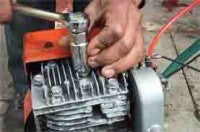Basic Fault Finding
Basic Fault Finding

By Clive Macintosh.
Over the coming weeks I will compile a series of workshops on basic maintenance and troubleshooting. These are designed as an aid for operators to do basic diagnosis when there are problems.
Petrol Engines-Will not start.
Here is a brief outline on a number of possible reasons for the engine not to fire.
1, No spark - Spark plug is fouled, the gap needs to be adjusted.
- - Damaged HT lead, incorrect points gap or dirty points.
- - Ignition coil or condenser faulty.
2, No fuel - No fuel in the tank.
- - Petrol pipe may be blocked.
- -Fuel needle sticking.
3, Lack of oil - Check oil levels.
4, Little or no power in the battery - Check water levels.
- Recharge battery.
5, Failed starter motor - Check movement once battery charged.
-------------------------------------
No Spark troubleshooting.
An Easy Summary:
On petrol engines, a current is generated by the magneto, which is attached to the flywheel.
The flywheel is fitted to the crankshaft, which is turned either manually (recoil starter) or electrically (starter motor).
When the engine is 'turned over' by one of the above two methods, the current generated via the magneto and ignition coil passes through the points. The points are the timing system that then transmits the spark at intervals to coincide with the piston reaching 'top dead centre' in the cylinder (Combustion chamber).
What to do:
1, Firstly undo and remove the spark plug from the cylinder head. Use a spark plug spanner to undo the plug carefully in an anti clockwise direction. Generally the plugs are in two sizes 19mm and 22mm.


2, Unscrew the suppresser cap from the end of the HT lead. Hold the HT lead, pressing the end against the cowling, which acts as earth. Turn the engine over and look for a spark. If there is no spark then the problem lies with either the HT lead itself, the ignition coil or the condenser. However these are less likely and I will cover them in more depth in the future. For now we assume that there is a spark at this juncture.


3, Replace the suppresser cap and fit the spark plug in. Hold the HT lead with plug attached against the cowling and again turn the engine. If there is no spark being generated here then the problem lies with either the plug or the cap.

Check that the plug is clean and free from carbon. Carbon build up is common on spark plugs. Also the heat generated by an engine can warp the plug gap, so check the gap with a measure, usually the gap is 25/1000 of an inch.


4, Once the plug has been cleaned and the plug gap checked repeat the process of turning the engine with the plug against the cowling.
If there is no spark then replace the plug and the suppresser cap- this will cost around £4.50.
However there is one more test that can be tried to narrow this down further. Unscrew the suppresser cap again and strip about 6mm (1/4") of insulation from the end of the HT lead. Wrap this around the spark plug, hold the Ht lead with the plug attached, to the cowling and turn the engine over. If there is a spark now, then only change the suppresser cap. If still no spark change both.
If there is a spark, then replace the plug in the cylinder head and tighten-Do Not over-tighten. Then replace suppresser cap on to the spark plug.

Whenever dealing with machines please take care, remember that there is a small electric current created when the engine is turned over, make sure that only the insulated part of the HT lead is held while checking for the spark.
In my next piece I shall talk about the faultfinding if there is no spark from the HT lead.
Best wishes,
Clive.

